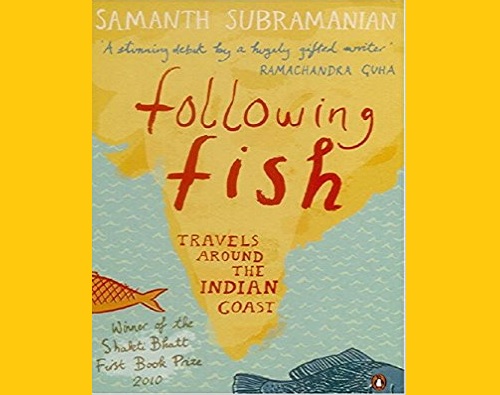Coastal narrations with some fish on the side.
I came to read Samanth Subramanian’s “Following Fish: Travels Around The Indian Coast” when I saw it mentioned in Curry; Eating, Reading and Race.
Subramanian’s journey through the Indian coast is both interesting and insightful. Through nine essays he manages to capture the role of fish and the sea in shaping cultures and communities. Following Fish is an excellent reminder that it is impossible to talk about food simply in the context of eating. For example, while exploring the coast of Kerala, Subramanian writes about toddy shops and the food served there.
“All toddy shop meen curries come furiously red with industrial dosages of chilli powder. In the average curry, the fish is incidental, a temporary tenant in, rather than the owner of, its overwhelming gravy. The question of which fish you would like in your curry is perfunctory and academic, you won’t be able to tell the difference.”
While in toddy shops, the fish serves a greater purpose, in Mumbai we join Subramanian in his search for authenticity, and here it is the drink before the fish that captures the reader’s attention.
“For a beverage that is intended to act as a digestive and go easy on the stomach, sol kadhi has a complex cross-section of tastes. Drinking Sushegad Gomatank’s sublime sol kadhi, coloured a pretty litmus purple by the kokum, I first tasted the coolness- if coolness can ever be a taste- of its coconut milk, then the citrus of the kokum, then an intense riot of spices (‘Pepper, mint, ginger, garlic, cloves, and cumin. We spice our sol kadhi much more than Malvanis.’), and then, like an ingenious reprise, the coconut milk again, but this time for a final note of sweetness.”
The author in this way manages to capture food, fish and everything around it to give us a picture of the table from the top.
But this book is not just about the culinary aspects of coastal life. One of my favourite chapters was about the famous fish treatment for asthmatics in Hyderabad. Having chronic asthma ever since I could remember, I have had people suggest this treatment numerous times. It’s interesting to read about fish here, turn itself into a medicinal carrier, a symbol of hope, and for some people- into another reason for skepticism.
Following Fish seamlessly moves between the table and the issues circling the waters. Overfishing, pollution, and the loss of a culture and occupation built around the sea- all make an appearance in the author’s conversations with fisherfolk and concerned citizens. A poignant moment in the book comes when the author uses an abandoned ship as a symbol of all things lost.
Reading the book eight years after it was published, one realizes we are still grappling with these issues.
“The GPS may have replaced the compass and the stars, and the engine may have helped to permanently stow oars and sail. But as Yeshi Chimbaikar pointed out to me in Mumbai, short of dredging the ocean floor, there isn’t yet a substitute for spending long hours on the water, praying for a misguided fish to wander onto a line or into a net. Fishing is still elemental in the most elemental sense of the word- an activity composed of water and air and light and space, all arranged in precarious balance around a central idea of a man in a boat, waiting for a bite.”
For more information visit the author’s website- http://samanth.in//.

